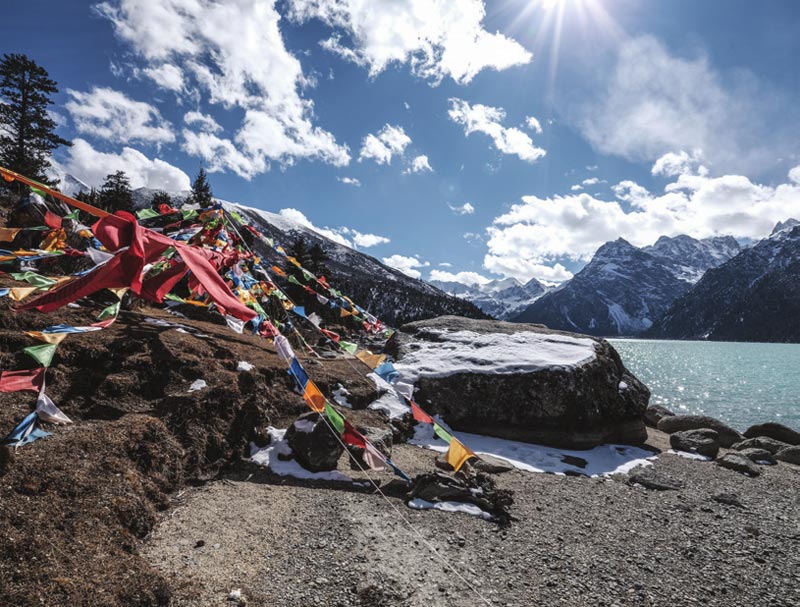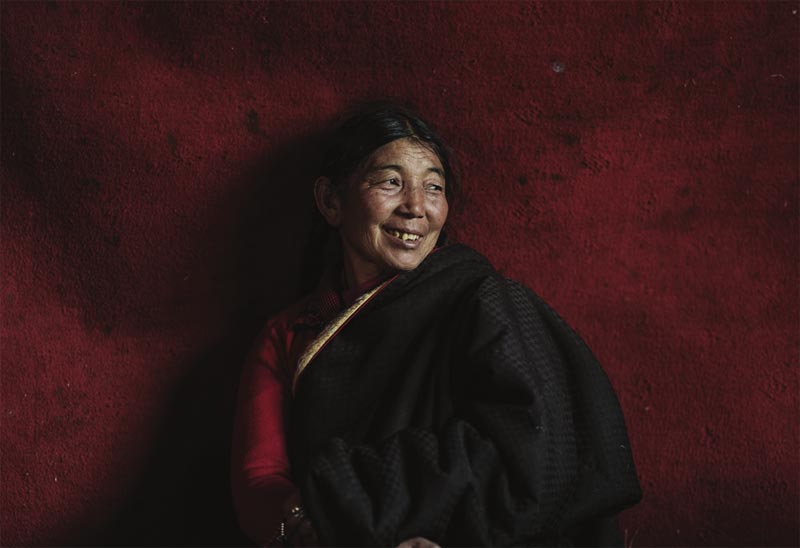IN THE WESTERN SICHUAN PROVINCE OF CHINA, LIES
GARZE TOWN, PART OF THE AUTONOMOUS REGION
OF TIBET.
Surrounded by rocky terrain and mountains at 4,000 metres above sea- level, Jose Jeuland found himself immersed in the life, colors and culture of the rosy-cheeked and free-spirited Tibetan locals.

A French photographer who is based in Singapore, Jose was entranced by the strength and vitality the Tibetan people exuded despite living amidst the harsh weather and living conditions. Adorable children filled with energy were running around while folks worked hard ploughing the fields. Temples and monasteries line the streets. The people living here are devout buddhists. They lead simple lives and are devoted to their strong religious beliefs.

The Tibet Autonomous Region is the second-largest provincial division of China by area, spanning over 1.2 million kilometre squares. However, due to its harsh and rugged terrain, it is the least densely populated Autonomous Region in China. Usually characterized as having a higher population of a particular minority ethnic group, Autonomous Regions in China have self-governing autonomy in the areas of education and language policy.
Long drawn to the traditionally colorful Tibetan costumes, people and their way of life, Jose was full of excitement as he embarked on his long-awaited journey to the Tibetan Autonomous Region. With his trusty camera in hand, he could not wait to meet with his eyes and lens the Tibetan culture and its people.



Journeying 15 hours from the city of Chengdu towards Ganze Town (also known as Ganxi), Jose met a young lady named Qi May Ze Young during the bumpy bus ride. Striking up a conversation with her, Jose found out that Tibetan names are usually composed in four syllables, which he found very interesting.
After hearing Jose share his reasons why he was traveling to her part of the world, the young Tibetan lady was kind enough to extend a warm invitation
to Jose to stay with her family for a period of 8 days. Of course, Jose was
ecstatic and jumped at the opportunity to live with an authentic Tibetan
family.
The family lived a one hour’s drive away from Ganze town, in Dege County. The hospitality and generosity of the Tibetan family bowled him over. Truth be told, it was not an easy experience for Jose. He was traveling in winter and temperatures were dipping below zero degrees at times. There were noshower, toilet and water facilities available. However, there was a wireless internet connection! Despite the harsh conditions, it was Jose’s best travel experience to date.
Though the family was not well-to-do, they made sure Jose was well-fed at
every meal. Going out of their way to make their guest feel comfortable,
Jose was extremely touched by the incredible magnanimity the Tibetan
family showered upon him.


The entire family slept in the same room to keep one another warm, and Jose slept in a separate room. The mother of the family cooked every day, and took care of Jose’s every meal. Some of the meat he consumed were frozen, and uncooked. The family refused to accept any form of monetary exchange from Jose, and even gave him precious tokens belonging to the family which Jose holds dear till today.
The natural landscape surrounding Jose’s stay was absolutely mesmerizing. Winter meant the mountains were lushly snow-capped and the raw beauty of the countryside, as yet untouched by industrialization tugged at Jose’s heartstrings and he determined to capture as much of it as possible. Jose forsees a return trip in the near future, as he feels a single trip is not time enough to document all that the Autonomous Region of Tibet has to offer.
Roaming the streets, Jose observed monks in colored robes walking about and people holding prayer wheels. The place is rich in its own unique culture and traditions that have been passed down for many generations. Numerous colorful prayer flags fly high and visibly, blowing in the wind. These hold great significance to the natives. Red seems to be a prominent color which is related to life force and preservation in Buddhism. Along the green pastures, one can see yaks, sheep and sometimes goats grazing the fields. The rolling countryside with its mountains, hills and other rocky terrains make up the scenic landscape of theTibetan Autonomous Region.
Agriculture is the area’s main industry and food is vital for them especially because of the country’s cold climate. It keeps them warm and gives them sufficient energy to carry out their activities for the day. Houses are made of stones, soil, wood and other raw materials like Yak’s poop. People live in small block houses clustered around the land, filled with colourful ornaments and decorations. Some houses are tucked away in remote areas, away from the city and roads, and closer to the vast nature that the place has to offer.
Donning comfortable and conservative clothes, the locals shield themselves from the harsh weather while making a statement with their individual styles. People are welcoming and hospitable, making them enjoyable to be around as they make you feel comfortable as a visitor.
Jose, with his keen desire to document to the fullest extent the Tibetan life and culture, bid a fond goodbye to the Tibetan family and ventured into an area named Yarchen Ga. There he stumbled upon the Tibetan practice of “sky burial”. In Tibet, the hard, rocky terrain makes it difficult to dig a grave. Most of Tibet is also above the tree line (a geographical line that marks the area that trees are unable to grow beyond), which makes it economically unfeasible to provide enough timber to conduct cremations.
Therefore, born out of both religious and practical considerations, “sky burial” is a funeral practice where the body of the deceased is respectfully disposed of on the top of a mountain, leaving it for the vultures to consume.
Most of the Tibetan people are Vajrayana Buddhists, and they believe in the transmigration of spirits. It is their belief that there is no need to preserve the body, and it becomes an empty vessel. The function of the sky burial is to dispose of the body in the most generous way possible, hence allowing carrion birds to feed on it.
Jose was privileged to witness a Rogyapa (loosely translated as “body-breaker”), carrying out his work. Before documenting the process, the relevant persons were asked for permission first. The images captured were indeed breath-taking and monumentally educational, as it is not a process that is easily or widely documented.
Though both the Rogyapa and Jose did not speak the same language, through simple gestures and basic words like “America” or “Europe” that the Rogyapa knew, Jose was able to convey that he was a photographer from France who was currently living in Singapore. Jose through his many travels has developed a good intuition in communicating with
speakers of other languages.
The views were absolutely breathtaking and Jose, who usually does not photograph much landscape scenery, felt absolutely compelled to capture the stunning countryside surrounding him during his journey.
In culture, people and landscape – The Autonomous Region of Tibet illustrates exoticism in every sense of the word. The elevation of the region makes the place and the travel experience even more unique.
Before leaving Tibet, Jose was given his very own Tibetan name, carefully thought of by his kind hosts: Si Lang Gong Bu. It means riches and honor with a peaceful life.
Credits:
Jose Jeuland is professional photographer based in Singapore and does documentary style photography, videography and also specialises in a wide range of styles for his commercial work. His latest exhibition on Longevity in Okinawa ended its run in May 2019 and he hopes to launch a new exhibition regarding his recent travel to Tibet in the coming months.
He shot all photos using his FUJIFILM GFX 50R with a FUJINON lens. Jose is thankful to Manfrotto and The North Face for providing essential travel gear that enhanced his travel documentary experience immensely.